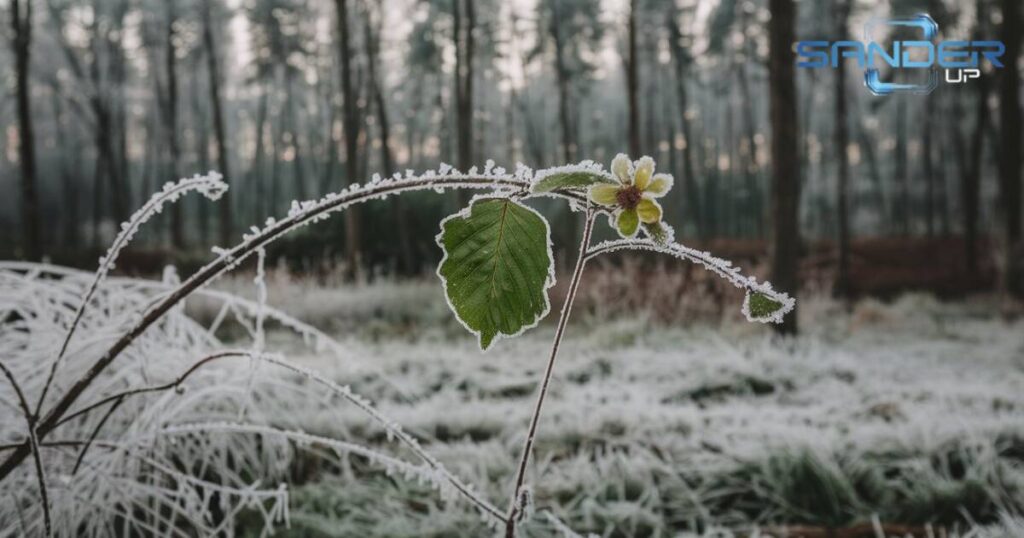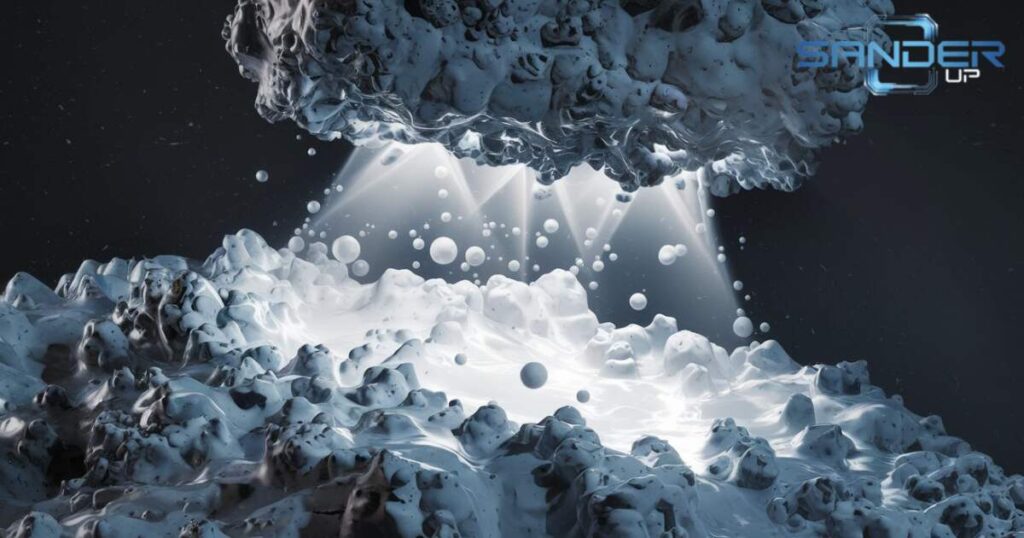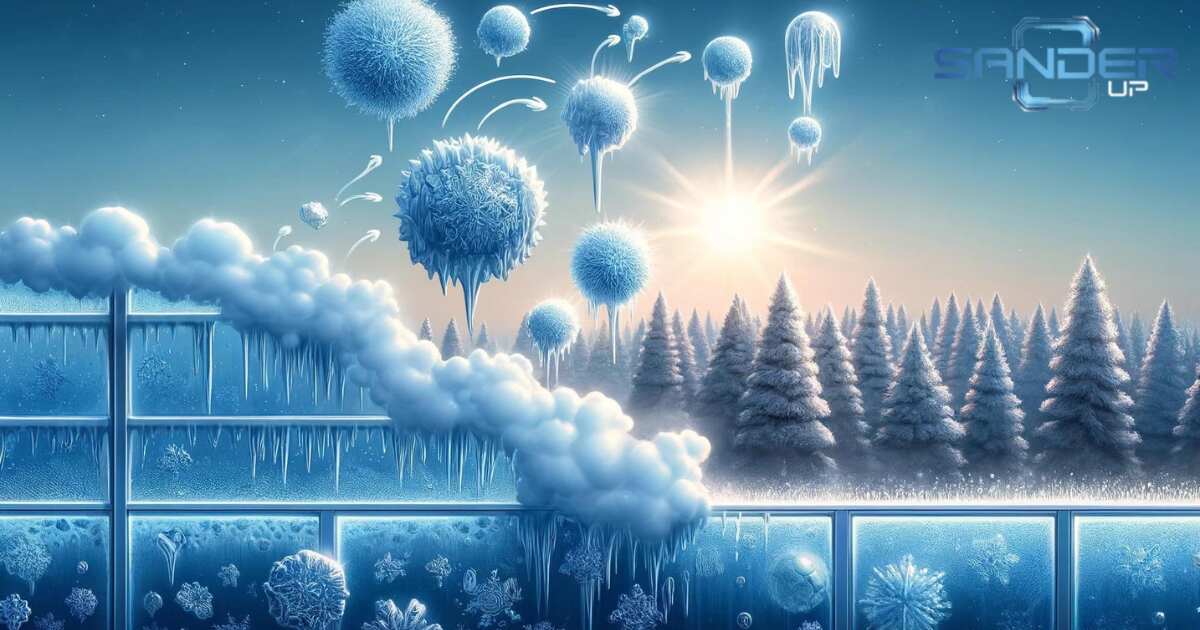Deposition is a phase change that occurs when a gas turns directly into a solid without passing through the liquid state. This process is the reverse of sublimation, where a solid changes directly into a gas.
Deposition typically happens under specific conditions where the temperature is low and pressure is high, causing gas molecules to lose energy rapidly.
In nature, deposition plays an essential role, especially in cold climates, where rapid cooling causes gas to solidify directly. It also occurs in many industrial applications where thin films and coatings are created.
Gas to solid is called – Deposition
When a gas transforms into a solid without becoming a liquid first, the process is called deposition. This occurs when gas molecules lose their heat energy and their movement slows down.
As a result, these gas molecules bond together to form a solid. Deposition commonly happens in the presence of a cold surface, where gas particles cool down rapidly and undergo this transformation.
The rate at which this happens depends on the temperature and atmospheric conditions, such as pressure. The process is seen both in natural environments and in industrial uses where cooling is involved.
Deposition differs from freezing because freezing involves the liquid state, while deposition skips the liquid phase entirely. For example, during freezing, water turns into ice, but in deposition, water vapor turns directly into ice.
This phase transition happens in environments with low temperatures, such as in high altitudes or cold regions of the Earth. Industrial applications use deposition to create layers of material, which is essential for products like electronic circuits and solar cells.
Example of Deposition
One of the most common examples of deposition in nature is the formation of frost. Frost forms when water vapor, which is in the gas state, comes into contact with a surface that is below freezing temperature.
As the water vapor cools rapidly, it loses energy and transitions directly into ice without passing through the liquid phase. This is why frost forms on cold surfaces like grass, car windows, or rooftops on chilly mornings.
Another natural example is the formation of snow in the atmosphere. High up in the clouds, water vapor cools quickly due to low temperatures, turning directly into solid ice crystals, which we recognize as snowflakes. These snowflakes form without becoming liquid water first.
In industrial processes, deposition is used in techniques such as Chemical Vapor Deposition (CVD). CVD is used to create thin films or coatings on materials by transforming gases into solids.
This method is crucial in the production of semiconductors, where very thin solid layers are needed to form circuits. Deposition also occurs in metal refining, where certain metals are extracted by turning their gases into solid metal layers.
Another industrial example is the buildup of soot on surfaces like chimneys. In this case, hot gas from burning fuel cools down and forms solid particles of carbon that stick to the walls, resulting in soot deposition.
Examples of Gas to Solid
1. Frost Formation

Frost is one of the most common examples of deposition in nature. It forms when water vapor in the air comes into contact with a surface that is below freezing. Instead of the water vapor condensing into liquid water, it loses energy quickly and turns directly into solid ice crystals.
This process happens on cold surfaces like grass, car windows, or rooftops, especially during early morning hours when temperatures drop below 0°C (32°F). Frost is often seen in colder climates and can form intricate patterns depending on the temperature and humidity levels.
2. Dry Ice Formation
Dry ice is solid carbon dioxide (CO2), and its formation involves a direct change from gas to solid. Carbon dioxide gas can be cooled at very low temperatures, around -78.5°C (-109.3°F), to turn directly into dry ice without becoming liquid.
Dry ice is widely used for refrigeration because it does not melt into liquid but sublimates back into gas, making it convenient for preserving items. The process of creating dry ice involves the rapid cooling and compression of CO2 gas, which then deposits into a solid form.
3. Snowflakes

Snowflakes are beautiful examples of deposition occurring high up in the atmosphere. In clouds, water vapor undergoes rapid cooling due to low temperatures. Instead of condensing into liquid water droplets, the vapor freezes directly into tiny ice crystals.
These crystals gather together, forming the intricate, hexagonal shapes we see as snowflakes. The structure of a snowflake depends on the temperature and humidity conditions during its formation. Snowflakes fall to the ground as solid ice particles, bypassing the liquid stage completely.
4. Iodine Crystals
Iodine is a substance that sublimates when heated, meaning it transitions directly from a solid to a gas. When this iodine gas cools, it undergoes deposition and forms solid iodine crystals again. This process can easily be observed in laboratories.
Iodine vapor is purple, and when it is cooled down rapidly, shiny, dark-gray crystals of iodine are deposited. This reversible process of sublimation and deposition is used in the purification of iodine, as it helps remove impurities through repeated cycles.
5. Camphor Crystals
Camphor, much like iodine, sublimes at room temperature. It is a white crystalline substance with a strong smell. When heated, camphor turns directly into gas, and as this gas cools, it undergoes deposition and forms solid camphor crystals again.
This phenomenon is often used in the purification of camphor, where the camphor vapor is collected and solidified back into pure crystals. The sublimation and deposition process helps in separating camphor from other impurities.
6. Freeze-Drying
Freeze-drying, also known as lyophilization, is a process used to preserve food and other materials by removing water through deposition.
In this method, the material is first frozen, and then the surrounding pressure is reduced to allow the frozen water (ice) to sublimate directly into vapor. This vapor then undergoes deposition, turning back into ice without becoming liquid, ensuring the material remains dry and preserved.
Freeze-drying is used extensively in the food industry, pharmaceutical industry, and even in space missions to provide long-lasting food and medication.
7. Airplane Contrails
Contrails, or condensation trails, are the white streaks seen behind airplanes flying at high altitudes. These form when water vapor produced by the airplane’s engines meets the cold air in the upper atmosphere.
The water vapor cools rapidly and undergoes deposition, forming tiny ice crystals that create the visible white streaks. These contrails are an example of how quickly gas can turn into solid under the right temperature and pressure conditions.
Depending on the humidity and temperature in the sky, contrails can either disappear quickly or linger for a long time.
8. Helium Snow
Helium snow is a rare phenomenon that occurs in extremely cold environments, such as on planets like Neptune or Uranus. These planets have temperatures so low that helium gas can freeze and turn directly into solid particles through deposition.
This process creates what is known as helium snow. Helium, which remains a gas at very low temperatures on Earth, requires extremely cold temperatures to solidify, making this deposition process unique to outer space environments.
9. Deposition of Metal Alloy
In industrial applications, metal alloys are often deposited in solid form directly from gas during processes like chemical vapor deposition (CVD) or physical vapor deposition (PVD).
These processes are used to create thin layers of metal on surfaces for electronic devices, semiconductors, and coatings. During deposition, metal gas particles cool down rapidly and transition into solid layers, forming a thin coating on the material.
This method is vital in manufacturing as it allows for precise control of layer thickness, which is crucial for electronics and other high-tech applications.
10. Metal Coatings
In the manufacturing industry, gas can deposit as solid metal coatings on surfaces through processes like sputtering. Sputtering is a physical vapor deposition technique where metal atoms are ejected from a target material and deposited onto a substrate.
This process is used to create durable and conductive coatings on various materials, enhancing their properties for applications in electronics, optics, and more.
11. Sulfur Deposition
When sulfur is heated, it can turn into a gas. As the sulfur vapor cools, it undergoes deposition and forms solid sulfur crystals. This can occur during volcanic eruptions or in laboratories, where sulfur vapor is cooled rapidly to produce solid crystals.
12. Phosphorus Smoke
Phosphorus vapor can also undergo deposition to form solid phosphorus when cooled. When phosphorus is burned, it produces a white smoke that consists of tiny phosphorus particles.
As these particles cool, they deposit back into solid phosphorus, often seen in laboratory settings where phosphorus is handled.
13. Aerosol Particles
In atmospheric science, aerosol particles can be formed through deposition processes. When gases in the atmosphere cool, certain compounds can condense and deposit onto surfaces, forming solid particulate matter. This is crucial in understanding air quality and environmental processes.
14. Soot Formation
Soot is produced during incomplete combustion of organic materials. As smoke cools, the gaseous carbon particles can deposit onto surfaces, forming solid soot.
This is often observed in chimneys and fireplaces, where carbon particles solidify on the walls. Soot deposition can impact air quality and contribute to health issues.
Industrial applications
Deposition technologies play a vital role in modern manufacturing, particularly in creating thin, high-performance coatings.
One method, known as evaporative deposition, involves heating solid materials to turn them into gas within a low-pressure chamber. The gas molecules travel and then deposit directly onto a target surface, forming a smooth, thin layer.
This process skips the liquid phase, allowing for precise coatings without mess. Physical vapor deposition (PVD) is a related method used to apply thin films to various surfaces.
During deposition, energy is released, making it an exothermic phase change. Many industries harness these technologies for various applications.
1. Toolmakers
Toolmakers use deposition processes to enhance the performance of cutting tools. Techniques like physical vapor deposition (PVD) and chemical vapor deposition (CVD) apply hard coatings to tools. These coatings improve durability, wear resistance, and cutting efficiency.
Coated tools last longer and perform better in manufacturing processes, reducing costs and downtime. The specialized coatings can be tailored to specific applications, ensuring optimal performance.
2. Aerospace and Automotive
In aerospace and automotive industries, deposition technologies are crucial for enhancing component performance. CVD is commonly used to coat turbine blades in jet engines. This coating provides thermal protection and resistance to oxidation.
In automotive applications, lightweight coatings improve fuel efficiency and reduce wear. These innovations lead to safer, more efficient vehicles and aircraft, contributing to overall performance and reliability.
3. Jewelry and Design
The jewelry and design industries utilize deposition techniques for aesthetic and functional enhancements. Electroplating deposits thin layers of precious metals like gold or silver onto base metals.
This process enhances the jewelry’s appearance and provides a protective layer against tarnishing. Designers also use deposition to create intricate textures and patterns, allowing for unique and artistic pieces. These techniques enable high-quality finishes that appeal to consumers.
4. Optics
In optics, deposition methods create high-quality coatings for lenses and optical devices. Anti-reflective coatings reduce glare and improve light transmission. These coatings are applied using techniques like CVD, enhancing the performance of glasses, camera lenses, and other optical instruments.
Some coatings are designed to reflect specific wavelengths of light, improving device efficiency. The result is better image quality and functionality in various optical applications.
5. Semiconductors
The semiconductor industry relies on deposition processes for manufacturing electronic components. Techniques like chemical vapor deposition (CVD) and atomic layer deposition (ALD) create thin films of materials on silicon wafers.
These layers are vital for the functionality of integrated circuits and microchips. Precise control over deposition allows for the production of smaller and more efficient devices. This advances technology in smartphones, computers, and other electronics, driving innovation in the industry.
Summary
Deposition is the process where a gas turns directly into a solid without becoming a liquid first. Common examples of deposition include frost formation, where water vapor turns into ice on cold surfaces.
Dry ice is made from carbon dioxide gas turning into a solid at low temperatures. Snowflakes form when water vapor in clouds freezes into ice crystals. Other examples include iodine and camphor crystals forming from their vapors.
Deposition is also used in freeze-drying to preserve food and in industrial processes to coat metals or create thin films for semiconductors and other high-tech applications.











